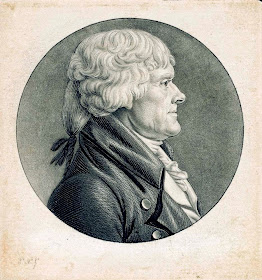Physiognotrace portrait of Thomas Jefferson
Charles Balthazar Julien Févret de Saint-Mémin (1770-1852), Physiognotrace portrait of Thomas Jefferson, n.d. [1804]. Engraving and copperplate. 7.1 x 6.6 cm. Graphic Arts French prints. Gift of Charles Scribner Jr., Class of 1943.
Eight years later, the French émigré Charles Balthazar Julien Févret de Saint-Mémin (1770-1852) brought a physiognotrace to the United States and Jefferson, now age sixty-one, again sat for a portrait. According to records at Monticello, Jefferson purchased 48 prints of his own portrait and collected a number of other portraits of friends and colleagues, which sold for about $25 each.
Both a print and the copper plate are on view in our Leonard L. Milberg Gallery for the exhibition, Capping Liberty: The Invention of a Numismatic Iconography for the New American Republic, on view through July 8, 2012.
See also Howard Rice, “Saint-Memin’s Portrait of Jefferson,” Princeton University Library Chronicle 20 (Summer 1959): 182-92. http://libweb5.princeton.edu/visualmaterials/pulc/pulcv20n_4.pdf
See also Thomas Jefferson Encyclopedia, Monticello: http://www.monticello.org/site/research-and-collections/jefferson-portrait-saint-m%C3%A9min-physiognotrace


No comments:
Post a Comment